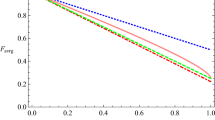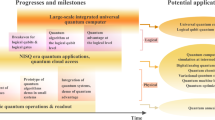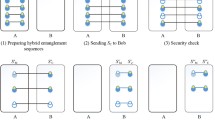Abstract
By combining two objects with no quantum effect one can get an object with quantum effect. Such a phenomenon, often referred to as activation, has been analyzed for the notion of steering nonlocality. Activation of steering nonlocality is observed for different classes of mixed entangled states in linear network scenarios. Characterization of arbitrary two qubit states, in ambit of steering activation in network scenarios has been provided in this context. Using the notion of reduced steering, instances of steerability activation are also observed in nonlinear network. Present analysis involves three measurement settings scenario (for both trusted and untrusted parties) where steering nonlocality is distinguishable from Bell nonlocality.
Graphical abstract







Similar content being viewed by others
Data Availability Statement
This manuscript has no associated data or the data will not be deposited. [Authors comment: The manuscript has no data associated with it].
Change history
22 August 2022
A Correction to this paper has been published: https://doi.org/10.1140/epjd/s10053-022-00478-4
References
A. Einstein, B. Podolsky, N. Rosen, Can quantum-mechanical description of physical reality be considered complete? Phys. Rev. 47, 777 (1935)
J.S. Bell, On the Einstein Podolsky Rosen paradox. Physics 1, 195 (1964)
R. Cleve, H. Buhrman, Substituting quantum entanglement for communication. Phys. Rev. A 56, 1201 (1997)
D. Mayers, A. Yao, Quantum cryptography with imperfect apparatus, in Proceedings of the 39th IEEE Symposium on Foundations of Computer Science IEEE Computer Society, pp. 503-509, Los Alamitos (1998)
C. Brukner et al., Bell’s inequalities and quantum communication complexity. Phys. Rev. Lett. 92, 127901 (2004)
J. Barrett et al., Nonlocal correlations as an information-theoretic resource. Phys. Rev. A 71, 022101 (2005)
A. Acín et al., Device-independent security of quantum cryptography against collective attacks. Phys. Rev. Lett. 98, 230501 (2007)
S. Pironio et al., Random numbers certified by Bell’s theorem. Nature 464, 1021 (2010)
R. Colbeck, A. Kent, Private randomness expansion with untrusted devices. J. Phys. A Math. Theor. 44, 095305 (2011)
J.D. Bancal, N. Gisin, Y.C. Liang, S. Pironio, Device-independent witnesses of genuine multipartite entanglement. Phys. Rev. Lett. 106, 250404 (2011)
R.F. Werner, Quantum states with Einstein–Podolsky–Rosen correlations admitting a hidden-variable model. Phys. Rev. A 40, 4277 (1989)
J. Barrett, Nonsequential positive-operator-valued measurements on entangled mixed states do not always violate a Bell inequality. Phys. Rev. A 65, 042302 (2002)
M.L. Almeida et al., Noise robustness of the nonlocality of entangled quantum states. Phys. Rev. Lett. 99, 040403 (2007)
R. Augusiak, M. Demianowicz, A. Acín, Local hidden-variable models for entangled quantum states. J. Phys. A: Math. Theor. 47, 424002 (2014)
A.F. Ducuara, J. Madronero, J.H. Reina, On the activation of quantum nonlocality. Universitas Scientiarum 21(2), 129–158 (2016)
S. Popescu, Bell inequalities and density matrices: Revealing “Hidden’’ nonlocality. Phys. Rev. Lett. 74, 2619 (1995)
N. Gisin, Hidden quantum nonlocality revealed by local filters. Phys. Lett. A 210, 151 (1996)
C. Palazuelos, Phys. Rev. Lett. 109, 190401 (2011)
M. Navascues, T. Vertesi, Activation of nonlocal quantum resources. Phys. Rev. Lett. 106, 060403 (2011)
A. Peres, Collective tests for quantum nonlocality. Phys. Rev. A 54, 2685–2689 (1996)
L. Masanes, Asymptotic violation of bell inequalities and distillability. Phys. Rev. Lett. 97, 050503 (2006)
L. Masanes, Y.C. Liang, A.C. Doherty, All bipartite entangled states display some hidden nonlocality. Phys. Rev. Lett. 100, 090403 (2008)
Y.C. Liang, L. Masanes, D. Rosset, All entangled states display some hidden nonlocality. Phys. Rev. A 8(6), 052115 (2012)
A. Sen(De), U. Sen, C. Brukner, V. Buzek, M. Zukowski, Entanglement swapping of noisy states: A kind of superadditivity in nonclassicality. Phys. Rev. A 72, 042310 (2005)
D. Cavalcanti, M.L. Almeida, V. Scarani, A. Acín, Quantum networks reveal quantum nonlocality. Nat. Comms 2, 184 (2011)
D. Cavalcanti, R. Rabelo, V. Scarani, Nonlocality tests enhanced by a third observer. Phys. Rev. Lett. 108, 040402 (2012)
A. Wojcik, J. Modlawska, A. Grudka, M. Czechlewski, Violation of Clauser–Horne–Shimony–Holt inequality for states resulting from entanglement swapping. Phys. Lett. A 374, 4831 (2010)
W. Klobus, W. Laskowski, M. Markiewicz, A. Grudka, Nonlocality activation in entanglement-swapping chains. Phys. Rev. A 86, 020302(R) (2012)
M. Zukowski, A. Zeilinger, M.A. Horne, A.K. Ekert, Event-ready-detectors Bell experiment via entanglement swapping. Phys. Rev. Lett. 71, 4287 (1993)
M. Zukowski, A. Zeilinger, H. Weinfurter, Entangling photons radiated by independent pulsed sources. Ann. New York Acad. Sci. 755, 91 (1995)
J.W. Pan, D. Bowmeester, H. Weinfurter, A. Zeilinger, Experimental entanglement swapping: entangling photons that never interacted. Phys. Rev. Lett. 80, 3891 (1998)
C.H. Bennett et al., Teleporting an unknown quantum state via dual classical and Einstein–Podolsky–Rosen channels. Phys. Rev. Lett. 70, 1895 (1993)
B. Paul, K. Mukherjee, D. Sarkar, Revealing hidden genuine tripartite nonlocality. Phys. Rev. A. 94, 052101 (2016)
E. Schrodinger, Discussions on probability relations between separated systems. Proc. Cambridge Philos. Soc. 31, 555–563 (1935)
E. Schrodinger, Probability relations between separated systems. Proc. Camb. Phil. Soc. 32, 446 (1936)
S.J. Jones, H.M. Wiseman, A.C. Doherty, Entanglement, Einstein–Podolsky–Rosen correlations, Bell nonlocality, and steering. Phys. Rev. A 76, 052116 (2007)
M.D. Reid, Demonstration of the Einstein–Podolsky–Rosen paradox using nondegenerate parametric amplification. Phys. Rev. A 40, 913 (1989)
Z.Y. Ou, S.F. Pereira, H.J. Kimble, K.C. Peng, Realization of the Einstein–Podolsky–Rosen paradox for continuous variables. Phys. Rev. Lett. 68, 3663 (1992)
E.G. Cavalcanti, S.J. Jones, H.M. Wiseman, M.D. Reid, Experimental criteria for steering and the Einstein–Podolsky–Rosen paradox. Phys. Rev. A 80, 032112 (2009)
S.P. Walborn et al., Revealing hidden Einstein–Podolsky–Rosen nonlocality. Phys. Rev. Lett. 106, 130402 (2011)
M. Zukowski, A. Dutta, Z. Yin, Geometric Bell-like inequalities for steering. Phys. Rev. A 91, 032107 (2015)
J. Schneeloch et al., Einstein–Podolsky–Rosen steering inequalities from entropic uncertainty relations. Phys. Rev. A 87, 062103 (2013)
S. Jevtic, M.J.W. Hall, M.R. Anderson, M. Zwierz, H.M. Wiseman, Einstein–Podolsky–Rosen steering and the steering ellipsoid. J. Opt. Soc. Am. B 32, A40 (2015)
F. Verstraete , A study Of Entanglement In Quantum Information Theory, Ph.D. Thesis, Katholieke universiteit Leuven (2002)
S. Jevtic, M. Puesy, D. Jenning, T. Rudolph, Quantum steering ellipsoids. Phys. Rev. Lett. 113, 020402 (2014)
S.J. Jones, H.M. Wiseman, Nonlocality of a single photon: Paths to an Einstein–Podolsky–Rosen-steering experiment. Phys. Rev. A. 84, 012110 (2011)
A.C.S. Costa, R.M. Angelo, Quantification of Einstein–Podolsky–Rosen steering for two-qubit states. Phys. Rev. A 93, 020103(R) (2016)
D. Collins, N. Gisin, A relevant two qubit Bell inequality inequivalent to the CHSH inequality. J. Phys. A: Math. Gen. 37, 1775–1787 (2004)
C. Branciard et al., One-sided device-independent quantum key distribution: Security, feasibility, and the connection with steering. Phys. Rev. A 85, 010301(R) (2012)
X. Ma, N. Lutkenhaus, Improved data post-processing in quantum key distribution and application to loss thresholds in device independent QKD, 2012. Quantum Inf. Comput. 12, 0203 (2012)
Y. Wang et al., Finite-key analysis for one-sided device-independent quantum key distribution. Phys. Rev. A 88, 052322 (2013)
C. Zhou et al., Finite-key bound for semi-device-independent quantum key distribution. Opt. Express 25, 16971 (2017)
E. Kaur, M.M. Wilde, A. Winter, Fundamental limits on key rates in device-independent quantum key distribution. New J. Phys. 22, 023039 (2020)
N. Walk et al., Experimental demonstration of Gaussian protocols for one-sided device-independent quantum key distribution. Optica 3, 634 (2016)
Y.Z. Law, L.P. Thinh, J.D. Bancal, V. Scarani, Quantum randomness extraction for various levels of characterization of the devices. J. Phys. A 47, 424028 (2014)
E. Passaro, E.G. Cavalcanti, P. Skrzypczyk, A. Acín, Optimal randomness certification in the quantum steering and prepare-and-measure scenarios. N. J. Phys. 17, 113010 (2015)
P. Skrzypczyk, D. Cavalcanti, Maximal randomness generation from steering inequality violations using Qudits. Phys. Rev. Lett. 120, 260401 (2018)
F.J. Curchod et al., Unbounded randomness certification using sequences of measurements. Phys. Rev. A 95, 020102 (2017)
B. Coyle, M.J. Hoban, E. Kashefi, One-sided device-independent certification of unbounded random numbers. EPTCS 273, 14–26 (2018)
M. Piani, J. Watrous, Necessary and sufficient quantum information characterization of Einstein–Podolsky–Rosen steering. Phys. Rev. Lett. 114, 060404 (2015)
K. Sun et al., Demonstration of Einstein–Podolsky–Rosen steering with nhanced subchannel discrimination. NPJ Quantum Inf. 4, 12 (2018)
P. Horodecki, M. Horodecki, R. Horodecki, Bound entanglement can be activated. Phys. Rev. Lett. 82, 1056–1059 (1999)
D. Mayers, A. Yao, in Proceedings of the 39th IEEE Symposiumon Foundations of Computer Science (IEEE Computer Society, p. 503. Los Alamitos CA, USA (1998)
A. Acín, N. Gisin, L.I. Masanes, From Bell’s theorem to secure quantum key distribution. Phys. Rev. Lett. 97, 120405 (2006)
N. Brunner, N. Linden, Connection between Bell nonlocality and Bayesian game theory. Nature Commun. 4, 2057 (2013)
A. Garg, N.D. Mermin, Correlation inequalities and hidden variables. Phys. Rev. Lett. 49, 1220 (1982)
I. Pitowsky, K. Svozil, Optimal tests of quantum nonlocality. Phys. Rev. A 64, 014102 (2001)
R. Uola, A.C.S. Costa, H.C. Nguyen, O. Guhne, Quantum steering. Rev. Mod. Phys. 92, 015001-1-015001–40 (2020)
J. Modlawska, A. Grudka, Increasing singlet fraction with entanglement swapping. Phys. Rev. A 78, 032321 (2008)
J. Bowles, F. Hirsch, M.T. Quintino, N. Brunner, Sufficient criterion for guaranteeing that a two-qubit state is unsteerable. Phys. Rev. A 93, 022121 (2016)
W. Song, M. Yang, Z.L. Cao, Sufficient criterion for guaranteeing that a two-qubit state is unsteerable. Phys. Rev. A 89, 014303 (2014)
S.S. Bhattacharya et al., Absolute non-violation of a three-setting steering inequality by two-qubit states. Quantum Inf. Process 17, 3 (2018)
J.D.M. Benjamin et al., Network quantum steering. Phys. Rev. Lett. 127, 170405 (2021)
J.F. Clauser, M.A. Horne, A. Shimony, R.A. Holt, Proposed experiment to test local hidden-variable theories. Phys. Rev. Lett. 23, 880 (1969)
L. Masanes, Y.C. Liang, A.C. Doherty, All Bipartite entangled states display some hidden nonlocality. Phys. Rev. Lett. 100, 090403 (2008)
S.J. Jones, H.M. Wiseman, A.C. Doherty, Entanglement, Einstein–Podolsky–Rosen correlations, Bell nonlocality, and steering. Phys. Rev. A 76, 052116 (2007)
N. Brunner, D. Cavalcanti, A. Salles, P. Skrzypczyk, Bound nonlocality and activation. Phys. Rev. Lett. 106, 020402 (2011)
M. Navascues, T. Vertesi, Activation of nonlocal quantum resources. Phys. Rev. Lett. 106, 060403 (2011)
Author information
Authors and Affiliations
Corresponding author
Additional information
The original online version of this article was revised: The affiliation of the author Soma Mandal was incorrect.
Appendices
Appendix A
Proof of Theorem 1
Both \(\rho _{AB}^{'}\) [Eq. (17)] and \(\rho _{BC}^{'}\) [Eq.(18)] violate Eq. (5). Hence, \(\sum _{j=1}^3{\sqrt{\mathfrak {t}^2_{1jj}}},{\sqrt{\mathfrak {t}^2_{2jj}}}\le 1\) which imply that \(|\mathfrak {t}_{kjj}|\le 1,\forall k=1,2\) and \(j=1,2,3.\) Let \(\mathcal {V}_{b_1b_2}\) denote the correlation tensor of conditional state \(\rho _{AC}^{(b_1b_2)}.\) Now, two cases are considered: either one or both the parties have no non-null local Bloch vectors. In both the cases, \(Tr (\mathcal {V}_{b_1b_2}^T\mathcal {V}_{b_1b_2})= \sum _{k=1}^3(t_{1kk}t_{2kk})^2,\,\forall b_1,b_2=0,1.\) Hence, for each of \(\mathcal {V}_{b_1b_2},\) \(\sqrt{Tr (\mathcal {V}_{b_1b_2}^T\mathcal {V}_{b_1b_2})}\) takes the form:
The second inequality holds as \(|\mathfrak {t}_{kjj}|\le 1,\forall k=1,2\) and \(j=1,2,3\) and the last is due to the fact that none of the initial states satisfies Eq. (5). \(\square \)
Appendix B
Proof of Theorem 3
Here, \(\vec {u_1}=\vec {u_2}=\Theta .\) \(\rho _{AB}\) and \(\rho _{BC}\) thus have the form:
Let \(\Lambda \) [Eq. (20)] be applied on both \(\rho _{AB}\) and \(\rho _{BC}\) followed by local unitary operations(to diagonalize the correlation tensors). Let \(\rho _{AB}^{(2)}\) and \(\rho _{BC}^{(2)}\) denote the respective canonical forms [Eq. (22)] of \(\rho _{AB}\) and \(\rho _{BC}\) [70]:
Now \(\rho _{AB}^{(2)}\) and \(\rho _{BC}^{(2)}\) both satisfy unsteerability criterion given by Eq. (23). This in turn gives:
where \(\hat{x}=(x_1,x_2,x_3)\) denotes a unit vector. \(\square \)
We next perform maximization over \(\hat{x}\) so as to obtain a closed form of the unsteerability criterion in terms of elements of correlation tensors of the initial states \(\rho _{AB}^{(2)}\) and \(\rho _{BC}^{(2)}\). Maximization over unit vector \(\hat{x}\): Taking \(\hat{x}=(\sin (\theta )\cos (\phi ), \sin (\theta )\sin (\phi ),\cos (\theta )),\) maximization problem in L.H.S. of Eq. (41) can be posed as:
where,
Now for any \(g_1,g_2\ge 0,\) \(Max _{\kappa }(g_1\cos ^2(\kappa )+g_2\sin ^2(\kappa ))\) is \(g_1\) if \(g_1>g_2\) and \(g_2\) when \(g_2>g_1.\) This relation is used for maximizing \(A(\theta ,\phi ).\) In order to consider all possible values of \((w_{k11}^{''})^2,\) \((w_{k22}^{''})^2\) and \((w_{k33}^{''})^2,\) we consider the following cases:
Case1:\((w_{k11}^{''})^2>(w_{k22}^{''})^2\): Then \(Max _{\phi }A(\theta ,\phi )\) gives:
Subcase1: \((w_{k11}^{''})^2>(w_{k33}^{''})^2,i.e., \,(w_{k11}^{''})^2=Max _{j=1,2,3} (w_{kjj}^{''})^2:\) Then \(Max _{\theta }B(\theta )=(w_{k11}^{''})^2.\) Hence,
Subcase2:\((w_{k11}^{''})^2<(w_{k33}^{''})^2,i.e., \, (w_{k22}^{''})^2<(w_{k11}^{''})^2<(w_{k33}^{''})^2:\,Then \,Max _{\theta }B(\theta )=(w_{k33}^{''})^2.\) Hence,
Case2:\((w_{k11}^{''})^2<(w_{k22}^{''})^2\): Then \(Max _{\phi }A(\theta ,\phi )\) gives:
Subcase1:\((w_{k22}^{''})^2>(w_{k33}^{''})^2,i.e., \, (w_{k22}^{''})^2=Max _{j=1,2,3}(w_{kjj}^{''})^2:\) Then\(\quad Max _{\theta }B(\theta )=(w_{k22}^{''})^2.\) Hence,
Subcase2:\((w_{k22}^{''})^2<(w_{k33}^{''})^2, i.e., \,(w_{k11}^{''})^2<(w_{k22}^{''})^2<(w_{k33}^{''})^2:\,Then \, Max _{\theta }B(\theta )= (w_{k33}^{''})^2.\) Hence,
So, combining all cases, we get:
So, the unsteerability criterion [Eq. (41)] turns out to be:
where \(k=1,2\) correspond to states \(\rho _{AB}^{(2)}\) and \(\rho _{BC}^{(2)}\), respectively. So \(\rho _{AB}^{(2)}\) and \(\rho _{BC}^{(2)}\) and therefore \(\rho _{AB}\) and \(\rho _{BC}\) are unsteerable. Steerability of state remaining invariant under application of linear map [Eq. (20)], considering the canonical forms \(\rho _{AB}^{(2)}\) and \(\rho _{BC}^{(2)}\) as the initial states used in the network. Depending on the output of BSM obtained by Bob (and result communicated to Alice and Charlie), the conditional states shared between Alice and Charlie are given by \(\rho _{AC}^{ij},\,i,j=0,1\) (see Table 4). \(\forall i,j,\) \(\rho _{AC}^{ij}\) has null local Blochs and diagonal correlation tensor.
Hence, for each of the conditional states, L.H.S. of Eq. (23) turns out to be:
Following the same procedure of maximization as above, the optimal expression of the maximization problem [Eq. (40)] is given by:
Using Eq. (39), the maximum value of Eq. (40) turns out to be \(\frac{1}{4}\). Each of the four conditional states thus satisfies the unsteerability criterion [Eq. (23)]. So if both the initial states satisfy Eq. (23) and have null local Bloch vector (corresponding to first party), then none of the conditional states generated in the network is steerable. Hence genuine activation of steering does not occur. States satisfies Eq. (5).
Appendix C
Details of the numerical observation given in Sect. 6: Without loss of any generality, of two initial states, let \(\rho _{BC}\) has non-null Bloch vector corresponding to the first party, i.e., \(\vec {u_1}=\Theta ,\vec {u_2}\ne \Theta .\) \(\rho _{BC}\) thus has the form:
After applying \(\Lambda \) [Eq. (20)] followed by local unitary operations, the canonical form \(\rho _{AB}^{(2)}\) of \(\rho _{AB}\) is given by Eq. (27), whereas that of \(\rho _{BC}\) is given by:
Now \(\rho _{AB}^{(2)}\) and \(\rho _{BC}^{(2)}\) both satisfy unsteerability criterion given by Eq. (23). This in turn gives:
and
with \(\hat{x}=(x_1,x_2,x_3)\) denoting unit vector. While the closed form of Eq. (42) is given by Eq. (39) for \(k=1,\) the same for Eq. (43) is hard to derive owing to the complicated form of the maximization problem involved in it. Now as \(\rho _{BC}^{(2)}\) satisfies an unsteerability criterion [Eq. (43)] so it is unsteerable and consequently violates Eq. (5):
As discussed above, the canonical forms \(\rho _{AB}^{(2)}\) and \(\rho _{BC}^{(2)}\) as the initial states used in the network. Depending on Bob’s output, the conditional states shared between Alice and Charlie are given by \(\rho _{AC}^{ij},\,i,j=0,1\) (see Table 5).
Let us consider \(\rho _{AC}^{00}.\) Using state parameters (Table 5) of \(\rho _{AC}^{00},\) L.H.S. of Eq. (23) becomes:
where \(\mathfrak {u}_{21}^{''},\mathfrak {u}_{22}^{''},\mathfrak {u}_{23}^{''}\) are the components of real valued vector Bloch vector \(\vec {\mathfrak {u}_{2}^{''}}.\) In Eq. (45), maximization is to be performed over \(x_1,x_2,x_3\), whereas the state parameters are arbitrary. Now the expression in Eq. (45) is numerically maximized over all the state parameters involved and also \(x_1,x_2,x_3\) under the following restrictions:
-
\(w_{111}^{''}\le \frac{1}{2}\)
-
\(w_{122}^{''}\le \frac{1}{2}\)
-
\(w_{133}^{''}\le \frac{1}{2}\)
-
\(\sum _{j=1}^3(w_{2jj}^{''})^2\le 1.\)
While the first three restrictions are due to the unsteerability of \(\rho _{AB}^{(2)},\) i.e., given by Eq. (39) for \(k=1,\) the last restriction is provided by Eq. (44)(a consequence of unsteerability of \(\rho _{BC}^{(2)}\)). Maximum value of the above maximization problem [Eq. (45)] turns out to be 0.75, corresponding maxima (alternate maxima exists) given by \(w_{111}^{''}=0.5,\) \(w_{122}^{''}=0.454199,\) \(w_{133}^{''}=0.46353,\) \(w_{211}^{''}=-1,\) \(w_{222}^{''}=0,\) \(w_{233}^{''}=0,\) \(\mathfrak {u}_{21}^{''}=1,\) \(\mathfrak {u}_{22}^{''}=0,\) \(\mathfrak {u}_{23}^{''}=0,\) \(x_1=1,\) \(x_2=0\) and \(x_3=0.\) Maximum value less than 1 implies that the original maximization problem [Eq. (45)], where maximization is to be performed only over \(x_1,x_2,x_3\)(for arbitrary state parameters) under the above restrictions (resulting from unsteerability of \(\rho _{AB}^{(2)},\rho _{BC}^{(2)}\)), cannot render optimal value greater than 1. Consequently conditional state \(\rho _{AC}^{00}\) satisfies the unsteerability criterion [Eq. (23)] and is therefore unsteerable. So, in case Bob’s particles get projected along \(|\phi ^{+}\rangle ,\) genuine activation of steering does not occur in the linear network. In similar way, considering, other three conditional states, it is checked that the unsteerability criterion [Eq. (23)] is satisfied in each case. Genuine activation of steering is thus impossible for all possible outputs of Bob. Hence when one of the initial states has null local Bloch vector corresponding to first party, genuine activation of steering does not occur.
Appendix D
See Table 6.
Rights and permissions
Springer Nature or its licensor holds exclusive rights to this article under a publishing agreement with the author(s) or other rightsholder(s); author self-archiving of the accepted manuscript version of this article is solely governed by the terms of such publishing agreement and applicable law.
About this article
Cite this article
Mukherjee, K., Paul, B. & Mandal, S. Revealing hidden steering nonlocality in a quantum network. Eur. Phys. J. D 76, 136 (2022). https://doi.org/10.1140/epjd/s10053-022-00469-5
Received:
Accepted:
Published:
DOI: https://doi.org/10.1140/epjd/s10053-022-00469-5




